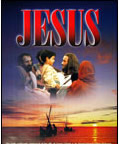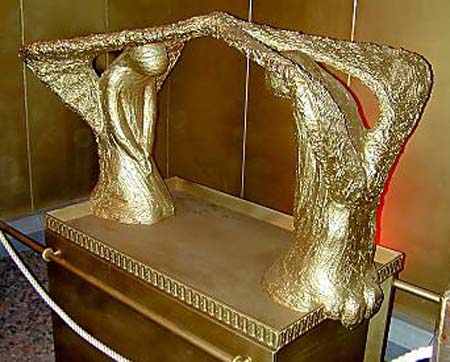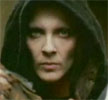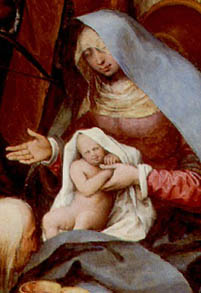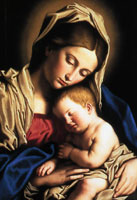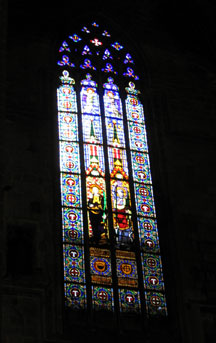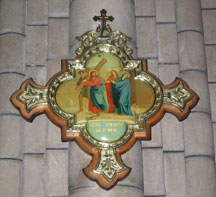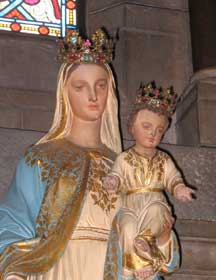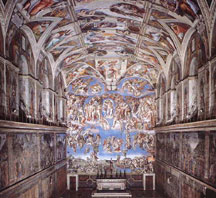| |
A Resource by Mark D. Roberts |
|
Visual Arts in Faith and Worship
by Rev. Dr. Mark D. Roberts
Copyright © 2005 by Mark D. Roberts
Note: You may download this resource at no cost, for personal use or for use in a Christian ministry, as long as you are not publishing it for sale. All I ask is that you give credit where credit is due. For all other uses, please contact me at mark@markdroberts.com . Thank you.
Reflection: Does The Passion of the Christ Violate the Second Commandment? (Part 1)
Part 1 in the series: "Visual Arts in Faith and Worship"
Posted at 9:38 p.m. on Sunday, February 29, 2004
Brad Jones of the delightfully entitled "Infinite Monkeys" blog has thrown down the gauntlet to several Christian bloggers, including me. He wants us to respond to the charge that The Passion of the Christ violates the second commandment. This charge has appeared in several Christian publications, including a pastoral letter that Brad has posted on his website.
The second commandment, by the way, prohibits the making of "graven images," to use the good ol' language of the King James Version (Exod 20:4). So the charge against The Passion of the Christ would be that making images of Jesus on film is making "graven images" and is contrary to God's will. This charge, incidentally, would apply to any and every film that pictures Jesus, including Franco Zeffirelli's classic Jesus of Nazareth and even the extraordinarily popular Jesus film.
|
The Jesus Film, I might add, has now been viewed by over 5 billion people in 236 countries. Almost 200 million of these people have made a personal commitment to Jesus Christ after seeing the film. But, even so, some would argue that its visual representation of Jesus is contrary to God's revealed will. Thus they would argue that no matter how "successful" the Jesus film might be in bringing people to Christ, it shouldn't have been made. |
Before I respond to the charge against The Passion of the Christ and other visual representations of Jesus, I want to make three preliminary comments. First, this issue is important, not only as it pertains to portrayals of Jesus in film, but as part of a much larger question, the question of the use of visual arts in Christian piety. In the past decade thousands of Bible-believing, evangelical, Christian churches have "discovered" the power of visual arts in worship. With PowerPoint projection leading the way, churches that used to rely solely upon the spoken word to proclaim the gospel and to inspire worship are now utilizing visual images: of nature, of people, of cultural symbols, of religious icons, and much more. The visual bandwagon is rolling and countless churches have jumped aboard. But have we stopped to ask a foundational question: Is it right? Is it consistent with Scripture to use visual images in worship? And, if so, what biblical guidance is there for the right use of these images in Christian faith and worship? (It just so happens that I have just recently published an article on this very question in the January/February issue of Worship Leader magazine. Though I can't reprint that article here, you can find it via the Worship Leader website.)
My second preliminary comment is that I appreciate the willingness of Christians to raise the question of whether The Passion of the Christ violates the second commandment or not. When vast numbers of believers are raving about this film, and when even greater numbers of people have become Christians through viewing the Jesus film, it takes courage to stand up and ask whether this is right or not. It also reflects a solid commitment to follow God's revealed truth, even when this truth might be contrary to conventional Christian wisdom. We live in a day when all Christians need to be both courageous and committed to God's truth. So I commend those who are willing to stick their necks out by criticizing cinematic portrayals of Jesus.
My third preliminary comment is to note that those who accuse The Passion of the Christ of being contrary to the second commandment are not wacky Christians enamored with some bizarre new twist on Scripture. In fact they are standing in a long line of Judeo-Christian tradition that forbids making images of God (and for Christians this includes graphic representations of Jesus). Of course Roman Catholic and Orthodox Christians have for centuries produced images of Christ. But among Protestants there has been much more reticence about this, if not outright rejection. Chief among the rejecters are my own theological forefathers as a Presbyterian, the Protestant Reformers (folk like John Calvin). They believed that images of God or Christ were necessarily idolatrous, and, furthermore, that they would undermine the efficacy of Christian preaching. (For an example of this critique applied to The Passion of the Christ , see the article by Ron Gleason that appeared in the Web Magazine of the Presbyterian Church in America.)
So, those who are accusing The Passion of the Christ and other films of breaking the second commandment are doing three things that I admire:
1. They are being courageous enough to stand against the flow of both culture and conventional Christian wisdom.
2. They are taking Scripture seriously, even if this leads to their unpopularity.
3. They are respectful of Christian history. Unlike some contemporary believers, they don't act as if authentic Christian faith was invented yesterday. I believe we all have much to learn from history, and that we Christians, in particular, have much to learn from Christian history.
So, having praised those who have accused The Passion of the Christ of violating the second commandment, I'm now ready to weigh in on the issue at hand - which I will do tomorrow, because this post has now violated the second commandment of blogging: Be brief!
Reflection: Does The Passion of the Christ Violate the Second Commandment? (Part 2)
Part 2 in the series "Visual Arts in Faith and Worship"
Posted at 11:10 p.m. on Tuesday, March 2, 2004
In my last post I began to respond to those who have criticized The Passion of the Christ as violating the second commandment, which forbids making "graven images" (Exod 20:4). I praised those who raised this issue for their courage, their commitment to Scripture, and their respect for Christian history. But I didn't begin to engage their argument. Now I will do so.
The second commandment reads, "Thou shalt not make unto thee any graven image, or any likeness of any thing that is in heaven above, or that is in the earth beneath, or that is in the water under the earth: Thou shalt not bow down thyself to them, nor serve them: for I the LORD thy God am a jealous God . . . (Exod 20:4-5, KJV). God alone is worthy of worship, and God will not share that worship with anything, whether gods or humanly-constructed images. If the representation of Christ in The Passion of the Christ is one of these images, then the film violates the second commandment. But is Jim Caviezel's Jesus such an image?
In Exodus 20:4 the Hebrew word translated as "graven image" is pesel . It means, literally, something that has been hewn or carved. It is used 31 times in the Hebrew scriptures, always for some physical object that had been chiseled out of stone or forged out of molten metal. It is never used in the Bible for a two-dimensional visual image. Thus a biblical literalist could say at this point that as long as Mel Gibson doesn't carve a statue of Jesus, he's not out of bounds. The Ten Commandments didn't speak directly to the issue of motion pictures. (What a surprise!)
But this response is too literal. Of course the Ten Commandments didn't refer to movies because they weren't yet invented. But is the principle of the second commandment, when rightly interpreted, nevertheless relevant to film and other two-dimension images? This may well be the case. Notice, however, that we're no longer applying Exodus 20:4 in a literal manner. We're now involved in the necessary but messy tasks of exegesis and interpretation (hermeneutics). One simply cannot say that the second commandment plainly and obviously forbids film representations of Jesus.
Most modern translations no longer use the literal phrase "graven image" to translate pesel . Instead they prohibit the making of an "idol" (Exod 20:4, NIV, NRSV, NLT, etc.). This surely adds something to the sense, in that idols are not visual images per se, but images or statues that are objects of worship.
The defense of this translation relies on several observations. First, and most importantly, when we read Exodus 20:4 in context, we find the prohibition against graven images followed by "Thou shalt not bow down thyself to them, nor serve them" (Exod 20:5). The apparent concern of the second commandment is not the making of an object of art, but making such an object in order to worship it .
Second, this interpretation is supported by the ancient Greek translation of the Hebrew Scriptures (the Septuagint), which often helps us to uncover the sense of the ancient Hebrew. The Septuagint of Exodus 20:4 reads: "You shall not make for yourself an idol [eidolon] . . . ." Thus the text prohibits, not the making of an image [ eikon ], but of an image or object made so that it might be worshipped.
| Third, this interpretation of the text is supported by the larger context of Exodus itself. Exodus 20:4 forbids the making of "graven images." But only five chapters later the Lord instructs Moses to make three-dimensional images of the cherubim (angels) from hammered gold (Exod 25:17-19). These are to be placed inside the holiest place in the tabernacle, the physical center of Israel's worship. Of course the Israelites are not to worship the cherubim, for that would turn them into idols. Nevertheless, they are artistic images of heavenly beings, placed within the tabernacle. Unless God is contradicting himself, which isn't possible, then the second commandment must not prohibit the making of religious images, but only the making of such images as objects of worship. |
|
An artist's rendition of the cherubim above the Ark of the Covenant. Photo from BiblePlaces.com |
Therefore, given the context of Exodus 20:4 and the larger context of Exodus, especially 25:17-19, the modern English translations do accurately render the sense of pesel with "idol." What the second commandment prohibits is making an image or statue that becomes the focus of worship. It does not prohibit the making of visual images, even images that might appear in the place of worship, as long as these images are not meant to be worshipped by those who see them.
I should also note here the larger theological point that God reveals himself through visual representations. Limiting ourselves to Exodus, we can think of God's revelation to Moses through the burning bush (3:2), to Israel through the pillar of cloud and the pillar of fire (13:21-22), through thunder, lightening, clouds, smoke, and fire on Mt. Sinai (19:16-18), and through the glorious cloud that covered the tabernacle (40:34-35). Clearly God wasn't afraid that such visual images would obscure or overpower his central revelation through the "ten words" of the Mosaic covenant. Of course these images were never to be worshipped. Nor did they fully represent God, as if any image could. But they were visual signs that pointed to God and conveyed certain aspects of his being, such as his holy power.
Let me sum up my argument. The second commandment prohibits the making of any image that is to be an object of worship. In a word, it forbids idolatry. So then, if Mel Gibson intended for the character of Christ in The Passion of the Christ to be worshipped, then he violated the second commandment. If he did not intend such, then he did not transgress this commandment. I think it's clear, from the movie itself and from everything Mel Gibson has said, that he never intended his visual depiction of Christ to be an object of worship. On the contrary, he hopes that people will be inspired by his art to offer worship to the true, triune God. Therefore I do not believe that The Passion of the Christ does in fact contradict the second commandment.
However, I do think there are dangers inherent in such a depiction of Christ, and to these dangers I'll turn in my next post.
Reflection: Some Dangers Inherent in the Visual Representation of Christ
Part 3 in the series "Visual Arts in Faith and Worship"
Posted at 10:00 p.m. on Wednesday, March 3, 2004
I began this series by responding to the question: Does The Passion of the Christ violate the second commandment? In other words, by making a visual image of Jesus, did Mel Gibson violate the commandment, which prohibits the making of "graven images"? In my last post I examined closely the text and context of the second commandment, showing that it prohibits, not the making of images per se, but the making of images as objects of worship. This is consistent with most modern translations, which render Exodus 20:4 as "You shall not make for yourself an idol . . . ." Therefore, unless Mel Gibson intended his cinematic Jesus to be worshipped, which is a ridiculous idea, then he did not violate the second commandment. Case closed.
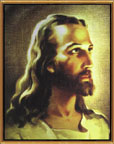 |
Or maybe not quite closed. Although I do not believe Mel Gibson can be faulted for his moving portrayal of Jesus, I do think there are dangers inherent in such visual representations of Christ (or of God in general). These dangers lurk whenever human beings attempt to depict Christ in visual arts, and they are more pronounced when a depiction is a emotionally-powerful one. For this reason, Mel Gibson's Jesus is even more dangerous today than, let's say, Warner Sallman's famous painting of the head of Christ. |
What are the dangers associated with visual representations of Jesus? One has to do with the limits associated with any such image. A visual portrayal of Jesus is never fully accurate; it never represents completely who Jesus was (and is). This would be true even if we had a photograph of Jesus, of course. But we can easily let one particular image of Christ become dominant in our understanding of and relationship with the living Lord. Thus whatever is lacking from the dominant image can end up shortchanging our faith.
| Let me give an analogous example from a different artistic medium. Some years ago a dear woman donated money to my church for stained glass windows. Her specific hope was that we would put a large image of Jesus receiving little children in a prominent window at the front of our sanctuary. Why? Because she had grown up in a church that had such a window, and, as she said, "Whenever I think of Jesus, I always think of that window. Whenever I pray, I picture the Jesus of that window." Now there was no doubt in my mind that this woman had a deep faith in Christ and that the window from her former church had at some point helped her grow closer to Christ. But I sensed that it also limited her understand and relationship with Christ in some ways. I felt strongly that we shouldn't display a visual image of Jesus in such a central window of our sanctuary. Only the cross should have such a central place. |
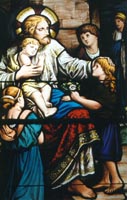 |
On the positive side, a powerful, biblically-inspired portrait of Jesus can help us to understand him more completely and relate to him more deeply. Yet, on the negative side, if one moving portrayal sticks in our minds, if it becomes our primary picture of Jesus, then our relationship with him will be limited. The real Jesus is always far greater and far more nuanced than any humanly-constructed image of him, however brilliant and accurate it might be.
For example, I found Mel Gibson's vision of Jesus to be very engaging. Some scenes in The Passion of the Christ , like that of Jesus praying in the Garden of Gethsemane, were astounding to me and helped me grasp something new about Jesus. But if I were to let the Jesus of that one scene become THE Jesus of my consciousness, then I'd no longer be letting Scripture inform my principal view of Jesus. Rather Mel Gibson's visual commentary on Scripture would be primary. In the end, I'd be relating to a truncated, human vision of Jesus.
What's the antidote to this? Though my theological ancestors would be quick to banish all images of Christ from our eyes and allow only verbal proclamation, I don't think this is a necessary or sufficient answer. The preaching of Jesus, which some see as the only safe presentation of biblical truth, can also be lopsided and incomplete. But our portrayals of Jesus, no matter what their form, and thus our faith in Jesus, will be more complete if we:
· Make the scriptural presentation of Jesus the only bedrock of our faith.
· Regularly read and meditate upon biblical presentations of Jesus, both in the gospels and throughout Scripture. Even within the Bible we have four divinely-inspired, distinct, complementary "pictures" of Jesus in the four gospels, not to mention the other biblical writings.
· Expose ourselves to a wide variety of human portrayals of Jesus in words, pictures, art, movies, etc. If you've seen The Passion of the Christ, check out the Jesus Film or Franco Zeffirelli's classic Jesus of Nazareth.
· Remember that any image of Jesus, no matter how moving and "inspired," is still a human creation, and therefore ultimately incomplete. Mel Gibson himself said in his interview with Diane Sawyer, when asked if his movie was the version of Christ's death: "No, not at all. Not at all. It really is my vision. . . . But I did it with God's help. I mean, this is my version of what happened according to the Gospels and what I wanted to show, the aspects of it I wanted to show."
· Let all visual and verbal representations of Jesus function as signs that point us to the real Jesus, whom we know truly through faith, through Scripture, and through the Holy Spirit who helps us to know Jesus (John 14:26; 15:26; 16:13-14).
If the relationship of the visual to Christian faith intrigues you, I would recommend a fine book by William A. Dyrness, Visual Faith: Art, Theology, and Worship in Dialogue (Grand Rapids: Baker, 2001).
Reflection: Satan and the Demonic Baby . . . Huh?
Part 4 in the series "Visual Arts in Faith and Worship"
Posted at 10:00 p.m. on Thursday, March 4, 2004
| Perhaps the strangest moment in The Passion of the Christ comes in the midst of Jesus' horrendous flogging. As he is being brutally beaten, the camera scans the crowd, focusing on the figure of Satan, who's standing mysterious in the background. Satan opens his/her robe to reveal a hideous little demonic baby. Weird! |
|
Rosalinda Celentano as Satan in The Passion of the Christ |
Obviously, this is one of those places in The Passion of the Christ where Mel Gibson goes beyond the literal New Testament accounts of Jesus' death. It's also one of the most puzzling moments in the film, by far. I've received many questions about this in the last couple of weeks.
Christianity Today did a great little piece called "What's Up With the Ugly Baby?" The magazine actually contacted Mel Gibson's people, who passed on Mel's comment about the scene. Here's what he said:
"Again, it's evil distorting what's good. What is more tender and beautiful than a mother and a child? So the Devil takes that and distorts it just a little bit. Instead of a normal mother and child you have an androgynous figure holding a 40-year-old 'baby' with hair on his back. It is weird, it is shocking, it's almost too much--just like turning Jesus over to continue scourging him on his chest is shocking and almost too much, which is the exact moment when this appearance of the Devil and the baby takes place."
So there you have it. But there's something more in this scene that would be obvious to many viewers, but not to others. The picture of Satan and the baby is a perfect anti-Madonna and child. Throughout the ages, Roman Catholic artists have painted pictures of Mary cradling Jesus in her arms. If you've seen many of these paintings, then the symbolism of Gibson's portrayal stands out even more starkly. Consider, for instance, how similar in form Gibson's scene is to the following classic Madonna and child paintings:
|
|
|
Pieter Breugel, 16th century |
Orazio Gentileschi, 17th century |
Julius Schnorr Von Carolsfeld, 19th century |
Once you see The Passion of the Christ, you can't miss the similarities between these images and Gibson's anti-Madonna.
Though one could object that Gibson is taking liberties with the story, I thought his satanic Madonna scene was brilliantly creative. As Jesus is being severely beaten because of his love for the world, we see a stark, scary picture of anti-love posing in the form of real love. As viewers - and as human beings - we are forced to ask what love is really about. Do we embrace the costly, sacrificial love of Jesus? Or do we prefer the comfortable but ultimately false love of Satan?
For an impressive collection of online Madonna and child paintings, see Dave Nation's website, from which I borrowed the pictures shown above.
The Excellence and Excesses of Art in Worship
Part 5 in the series “Visual Arts in Faith and Worship”
Posted at 9:00 p.m. on Monday, June 13, 2004
Europe is filled with churches. And these churches, though no longer filled with people, are filled with art: great art, beautiful art, priceless art. Of course I’m referring to Catholic churches, because most Protestant churches, in reaction to what was believed to be Catholic excess, severely limited or even banned artistic expression from places of worship.
Some of the most excellent art in the world can be found in European churches. And I’m not referring only to the most famous examples, such as Michaelangelo’s Pietà in St. Peter’s Basicila in Rome, or the astounding frescoes of the Sistine Chapel. Consider the cathedral in Barcelona, for example. It is filled with paintings, statues, and other art objects. Its stained glass windows are particularly stunning. As a lover of beauty and religious symbolism, I couldn’t help but be moved by the excellence of the art in this cathedral. |
|
| |
From the Barcelona Cathedral |
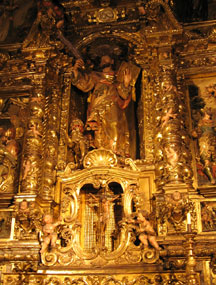 |
But I also had to wonder: Does artistic excellence ever become excessive? Consider, for example, one of the most striking artistic displays in the Barcelona Cathedral, a small chapel in honor of St. Mark the evangelist. My small photo can hardly do justice to the golden glow, indeed, the rich opulence of this chapel. Its intent is to honor St. Mark, the writer of the second gospel, and to inspire prayer. But is there too much gold here, too much elaboration, too much worldly excellence? Should some of the money invested in this chapel have been used to feed the poor or clothe the naked?
I stand too far away from this chapel’s artist and his world to understand his values and priorities. Maybe he created this chapel with every intention of glorifying God. And maybe God was indeed glorified by his creation. But I still have to wonder if so much gold, so much lavishness, goes beyond some standard of Christian artistic excellence. When you consider that the Gospel of Mark is a call to servanthood and suffering, it’s hard to see how Barcelona’s golden chapel is congruent with the heart of the biblical writer it celebrates with such opulence. |
The Chapel of St. Mark in the Barcelona Cathedral
|
|
Yet I don’t want to enter through the wide gate of dumping on the excesses of somebody’s else’s Christian art and thereby avoid the narrow gate of self-examination. Although the sanctuary of my church is not nearly as lavish as the Barcelona Cathedral, it does include several works of visual art, notably in our glass windows. What makes my windows okay and the Chapel of St. Mark excessive? How can I judge if and when my commitment to artistic excellence becomes excessive? If the hearts of the artists (and, indeed, the benefactors) are truly set upon glorifying God, are any artistic expressions okay? Is there ever a point when one can say, “This piece of art is too much, too elaborate, or even too expensive”? Or could it be that, as long as human motivations are right, no work of art could be too glorious, since it is meant to glorify the God whose glory is boundless? |
|
| |
A window in the Irvine Presbyterian sanctuary, signifying the lion in Rev 4:7 |
For those of you who like answers, this blog entry will be frustrating. I’m not yet ready to answer the questions I’ve asked. I’m still mulling them over. If you have any ideas, please e-mail me.
Home
Images of Jesus in Christian Tradition
Part 6 in the series “Visual Arts in Faith and Worship”
Posted at 9:00 p.m. on Tuesday, June 15, 2004
In some of my discussions of Mel Gibson’s movie The Passion of the Christ, I mentioned how much the filmmaker’s visual representations of the crucifixion reflected Roman Catholic art throughout the centuries. (See, for example, “Satan and the Demonic Baby . . . Huh?”)
Now, having recently visited many churches in Southern Europe, I’m even more impressed with how fluent Gibson is in the “language” of Catholic Christian art. Of course every church I visited had at least one crucifix, if not several. But I was impressed with other visual representations that Gibson captured in his movie. For example, all of the churches included the traditional “Stations of the Cross,” visual images of Jesus’ suffering, images that include many dramatic falls as he carries the cross to Golgotha. (This was something non-Catholics often didn’t “get” in The Passion of the Christ. A common question was: “Why did Jesus have to fall so much while carrying his cross?” Answer: “Because it’s consistent with the stations of the cross.”) One of these stations is an encounter between Jesus and his mother on the Via Dolorosa, one of the most powerful moments in Gibson’s film, yet something that is not narrated in the biblical gospels. |
|
| |
One of the stations of the cross in the cathedral in Monaco, where Jesus meets Mary on the Via Dolorosa
|
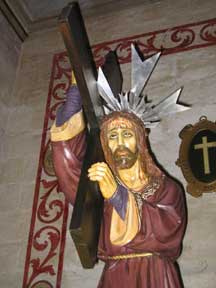 |
But I was especially struck by the large number of representations of a suffering Jesus. One of the most stirring was in a church in Mahon, on the island of Menorca. I don’t know anything about the date of this sculpture. But I do know that I found the grief of Jesus to be deeply moving.
In my Protestant upbringing, I can’t remember ever seeing a picture of a “sad” Jesus. We focused instead on the loving Jesus (Jesus and the children) or the “strong” Jesus (both pre- and post-Resurrection). Of course it’s not wrong to display images of the caring, powerful Jesus. And it’s not wrong to portray him in his agony. The problem comes when things get out of balance, when we emphasize only certain dimensions of Jesus’ life to the exclusion of others. It seems to me that most Christian traditions fall into this trap. |
An image of Christ from the St. Francis Church in Mahon |
|
Some Christians solve this problem by prohibiting all visual images of Jesus. I believe, however, that there is a biblically defensible place for graphic depictions of Christ. But I also believe we need to strive for balance and completeness as we display these images. Perhaps one of the advantages of the greater interaction between Protestants and Catholics will be a broadening of our understand and experience of Jesus, along with a parallel expansion of our visual traditions. Wouldn’t it be something to find a crucifix in a Protestant church, and an empty cross in a Catholic cathedral?
Home
Re-Creating the Bible in Our Own Image
Part 10 in the series “European Reflections”
Part 7 in the series “Visual Arts in Faith and Worship”
Posted at 9:00 p.m. on Wednesday, June 16, 2004
When we create visual images of Bible stories, it’s natural for us to create them in our own image. We tend to make Bible characters look like us and even act like us.
| I was struck by this fact as I visited many churches in southern Europe. In the Cathedral of the Immaculate Conception in Monaco, for example, I was impressed by a sculpture of Mary and Jesus, the Madonna and child. This is a strikingly beautiful sculpture, with a “perfect” woman holding a “perfect” baby. They look perfect if you happen to be from Western Europe, I should add. My guess is that neither of these figures would measure up to the Semitic image of perfection. And, of course, the real Mary and the real baby Jesus not only didn’t look European, but also it's unlikely that they were crowned with lavish, golden, jewel-filled crowns in the Bethlehem stable. The sculpture of the Madonna and child from the church in Monaco is clearly an idealization, not an attempt to portray the historical Mary and Jesus. |
|
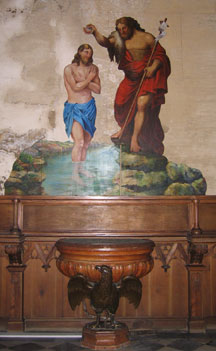 |
In Mahon, a city on the small island of Minorca, I was impressed by a fresco of the baptism of Jesus that adorned the baptismal niche of the Church of Santa Maria. John the Baptist is baptizing Jesus in the Jordan River, but not by immersing him in the water. Rather, John is pouring water on Jesus’ head from a small shell he holds in his hand. This picture reflects the tradition of the Minorcan church more than what really happened in the baptism of Jesus. Quite certainly Jesus was baptized through immersion. As the Gospel of Mark reads, “In those days Jesus came from Nazareth of Galilee and was baptized by John in the Jordan. And just as he was coming up out of the water, he saw the heavens torn apart and the Spirit descending like a dove on him” (Mark 1:9-10). If Jesus was “coming up out of the water,” then he had previously been down in it. (You can trust me on this, because I’m a Presbyterian, not a Baptist. Most of the time I baptize by sprinkling, not immersion. No theological agenda here!) |
You’ll notice that my descriptions of what I saw in Monaco and Mahon are objective. I haven’t weighed in on whether I think it’s good or bad that our artistic representations of biblical stories tend to paint reality in ways that fit our own culture, rather than the biblical culture. In fact I think this can be good or bad or both. On the one hand, visualizing biblical stories in ways that are familiar to us helps us to “get into” the story. It’s a way of translating the biblical text into a more familiar idiom (much as we do when we translate New Testament Greek into English). On the other hand, such graphic translation can fool us into thinking that our way is “the biblical way,” without realizing how far we may be from biblical reality.
When it comes to visualizations of Jesus, if we see Jesus simply as one just like us, we’ll tend to miss his distinctiveness as a Jewish man. Thus it will be easy for us to misconstrue his message and ministry as well, both of which can be understood only in their Jewish context. (See my book, Jesus Revealed, for ample evidence of this.) Even more dangerous is the tendency, once we have envisioned Jesus as a Western European, to become anti-Semitic. If we’re continually confronted by images of very Jewish Jesus, however, it will be harder to look down upon Jews in general.
I do not think artists who portray biblical images must strive for historical literalism. They are free to be creative in the reinterpretation of the biblical stories. Yet it’s crucial for those of us who are influenced by their art to see reinterpretations for what they are, and to discern an artist’s distinctive statement without projecting that statement onto the biblical text.
Home
Michaelangelo’s Surprising Sistene Reticence
Part 11 in the series “European Reflections”
Part 8 in the series “Visual Arts in Faith and Worship”
Posted at 9:00 p.m. on Thursday, June 17, 2004
One of the highlights of my recent trip to Europe was a visit to the Sistine Chapel. (Note to future travelers to Rome: You can’t visit the Sistine Chapel all by itself. It’s the final part of the trek through the giant Vatican Museum. You don’t have to go through the entire museum to see the chapel, but you can’t go straight to the chapel either. Of course I would highly recommend that you take at least a couple of hours to make your way through the astounding exhibits in the whole Vatican Museum.)
The Sistine Chapel is perhaps the most famous church in the world (vying, I suppose, with St. Peter’s Basilica). At any rate, the art in the chapel is the most well-known of all church art. It includes stunning presentations the biblical story, including the Creation on the ceiling and the Last Judgment on the wall above the altar. |
|
| |
The front wall and ceiling of the Sistine Chapel. The Creation is at the very top of this picture. The Last Judgment is straight ahead, above the altar. |
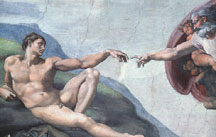 |
The most well-known portions of the chapel were painted by Michaelangelo, who had been personally chosen by the Pope of his day for this task. I knew this before my visit to the chapel. What I did not know until this visit, however, was that Michaelangleo really didn’t want to take on this project. Why not? Because he thought of himself primarily as a sculptor, and not a painter. He wasn’t sure he could do justice to the material in only two dimensions, and so he tried to get out of the job. But the Pope remained steadfast, and so Michaelangelo ended up creating one of the world’s greatest masterpieces. |
The creation of Adam, from the roof of the Sistine Chapel. (Note: I did not take any of these pictures. Visitors to the chapel are not allowed to take pictures.) |
|
If find this story both surprising and, somehow, comforting. It reminds me of my relationship with God. God often, it seems, wants me to do things I don’t necessarily want to do. For example, I did not at first have any interest in becoming the pastor of Irvine Presbyterian Church, and came very close to rejecting the interest of the church’s search committee. Being the senior pastor of a medium-size suburban church just didn’t fit my picture of what I was best suited to do. But God had other plans, a fact for which I am now very glad. Like Michaelangelo, my job was to be obedient to my authority and to trust the results to God. My work at Irvine Presbyterian will never be thought of as a masterpiece, but God has used and blessed my efforts for his glory.
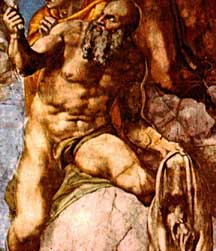 |
One final note of interest: On the massive Last Judgment wall there is a picture of St. Bartholomew. This saint, one of the 12 original disciples of Jesus, is believed to have evangelized in the East, including Iran and Armenia. He is said to have been martyred by being skinned alive. Michaelangelo represents this tradition by picturing the resurrected Bartholomew holding a human skin. But the face on this skin looks nothing like the saint. Most art historians believe that the face on the skin is actually that of Michaelangelo himself, who, like many painters of his era, including himself in his painting. But what an ironic and humble form!
Home
|
Michaelangelo's picture of St. Barthelomew holding a skin with a surprising face. |
|
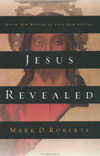 |
If you are looking for scholarship on Jesus that is careful and yet readable, you might find my book Jesus Revealed to be helpful. Each chapter summarizes historical evidence that helps us to understand Jesus, yet in a way that is meant for non-specialists. Plus, each chapter also connects the historical discussion to our personal faith today.
For more information on this book, click here. |
Home
|





